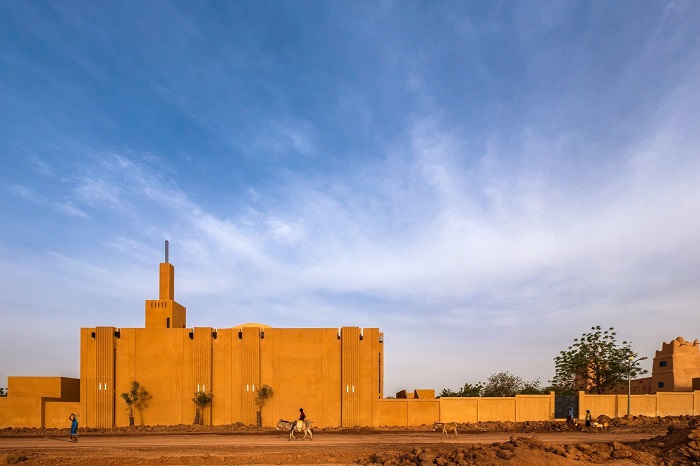ISABEL RUBIO ARROYO | Tungsteno
Nigerien architect Mariam Issoufou Kamara is convinced that modernity is not only synonymous with European design. That view dismisses the rest of the world as "faraway places that have only sometimes provided us with beautiful but primitive structures, while Western buildings are the ones worthy of true regard." "Suddenly, we can’t imagine designing without concrete, wood, glass or steel, yet they are far from being universally used around the world." On the occasion of International Women's Day on 8 March, we investigate the life and work of this architect who has received several awards in recent years and runs her own architecture studio, where she pays homage to African constructions.
"I was being asked to unlearn what I knew to be true."
Kamara was born in 1979 in Saint-Étienne, a city in south-eastern France, but her family moved to Niger a few months later. Even then, she was fascinated by the buildings she saw in the city of Agadez, "a place with centuries-old architecture that people still in live today." It was something that stayed with her and later motivated her to leave her career as a software developer to study architecture.
While studying in the United States, she realised how little time she spent studying buildings outside of Europe. "I was constantly being asked to unlearn what I knew to be true," Kamara, who received her master's degree from the University of Washington's School of Built Environments in 2013, tells Archdaily. "There is a perception that we—80 percent of the planet—are just receptacles for Europeans’ and Americans’ grand visions," she says.

Kamara helped convert a former mosque into a library and community centre in Dandaji, Niger. Credit: Atelier Masōmī.
Other architects have spoken along the same lines. One such person is Mabel O. Wilson, professor at Columbia University Graduate School of Architecture, Planning and Preservation (GSAPP): "Modern architecture builds the world for the white subject, maintaining the logics of racism while also imagining a future world in which nonwhite subjects remain exploitable and marginal."
A tribute to traditional African architecture
In 2014, Kamara founded Atelier Masōmī in Niamey, the capital of Niger. An example of her studio's architecture is the construction of the Dandaji market, whose design is reminiscent of the area’s traditional market with adobe posts and reed roofs. But in this case, compressed earth bricks and metal were chosen for durability. Among the studio’s ongoing creations is the Niamey Cultural Centre. This project, according to the studio itself, "puts a strong accent on climate mitigation solutions and sustainable practices of using local materials, rainwater harvesting and solar energy, while allowing the continued use of the site as an urban agriculture hub."

The design of the Dandaji market references a traditional one. Credit: Atelier Masōmī
Kamara is also one of the founders of the architecture collective united4design, which has projects in Afghanistan, the United States and Niger. In the African country, the collective completed Niamey 2000 Housing, a 1,700-square-metre housing development designed in response to the housing crisis in Niamey. "There has always been a lot of housing for the upper and lower classes but nothing for the middle classes. A good example is that there are quite a few young people who can't get married for the simple reason that they can't find a place to live," Kamara explains. While her design pays homage to the traditional architecture that used to be found in Mali, Niger and Nigeria, it was built with unfired earth masonry and uses passive cooling techniques to protect against high temperatures.
Kamara's second collaborative project was the Hikma Religious and Secular Complex. Her goal was to transform a derelict mosque in the village of Dandaji into a library and a new mosque.
Niamey 2000 was designed in response to the housing crisis in Niger's capital. Credit: African Mobilities
Why the Philippines "looks like an American suburb"
Kamara is now working to train a new generation of architects at conferences organised by MIT, Columbia University GSAPP, the African Futures Institute in Ghana and Harvard's Graduate School of Design (GSD). At Harvard, Kamara asked students to design speculative projects for a site in the Boston area after learning about the region's indigenous influences. Although indigenous precedents are part of North America's DNA, according to Kamara, they are often missing or inaccessible because a colonial value system encourages students to ignore them.
This project made students like Kathlyn Kao rethink some questions: "I'm doing my thesis about migrants from the Philippines, where my family is from, and I’m hesitant about American architects doing work abroad. Why the Philippines looks like an American suburb is concerning for me." Another of her students, Thomas Kuei, says that "just talking to people from a location doesn't mean you know the location. Talking to local people doesn't mean you're getting the whole story. You’re only getting a snapshot from when those people entered the scene at that specific location," he says.
· — —
Tungsteno is a journalism laboratory to scan the essence of innovation.
